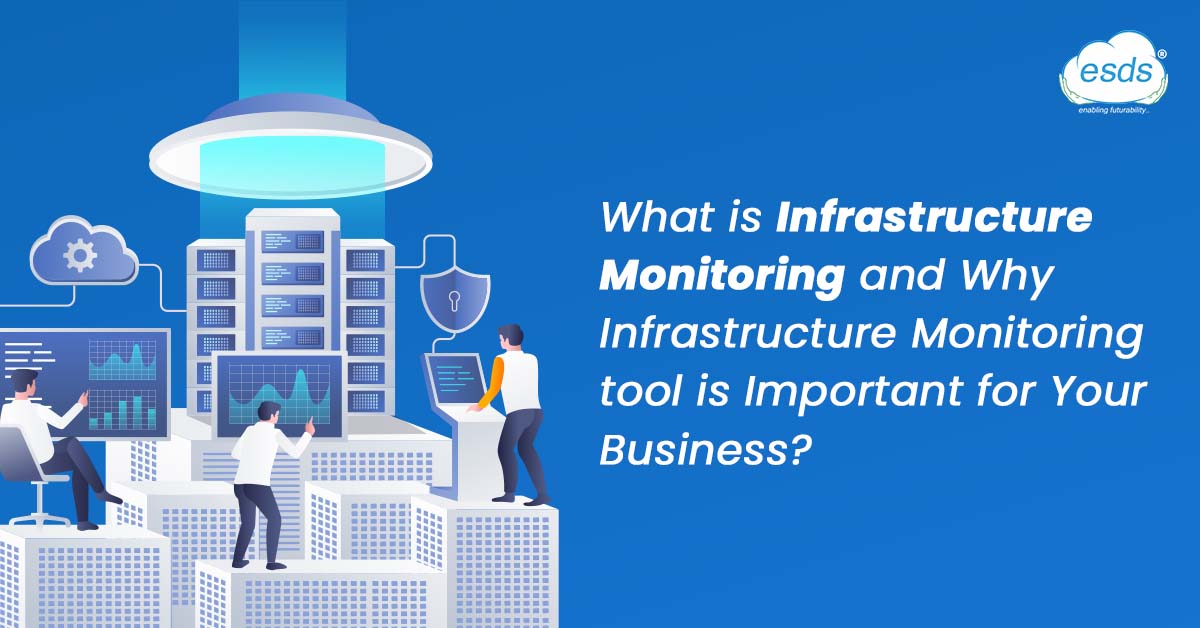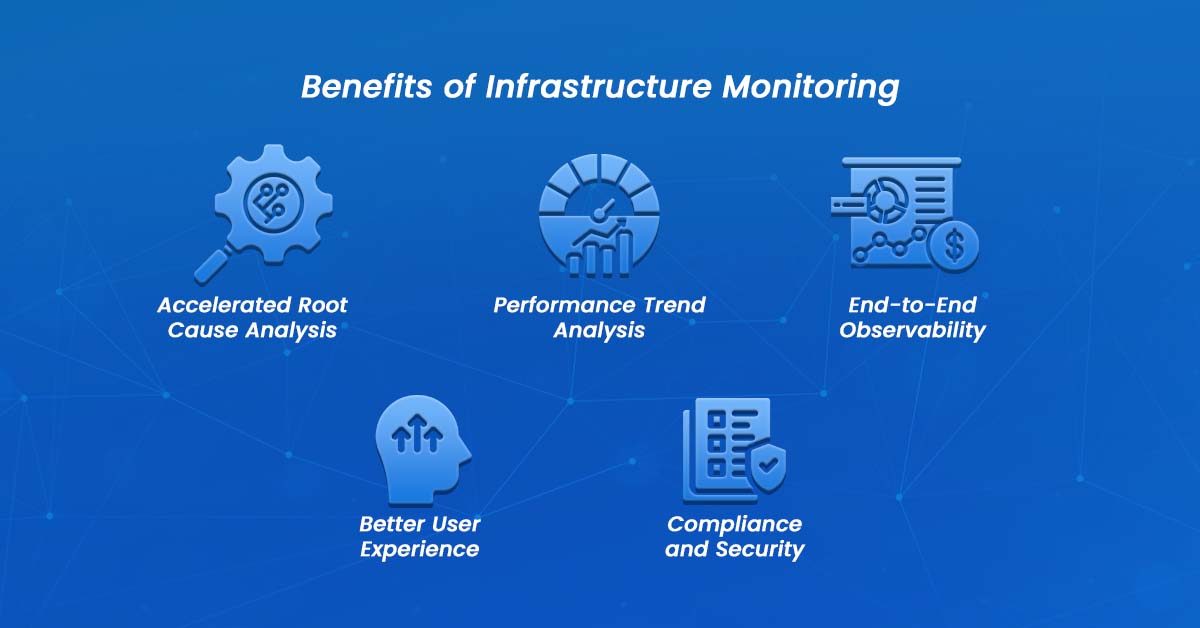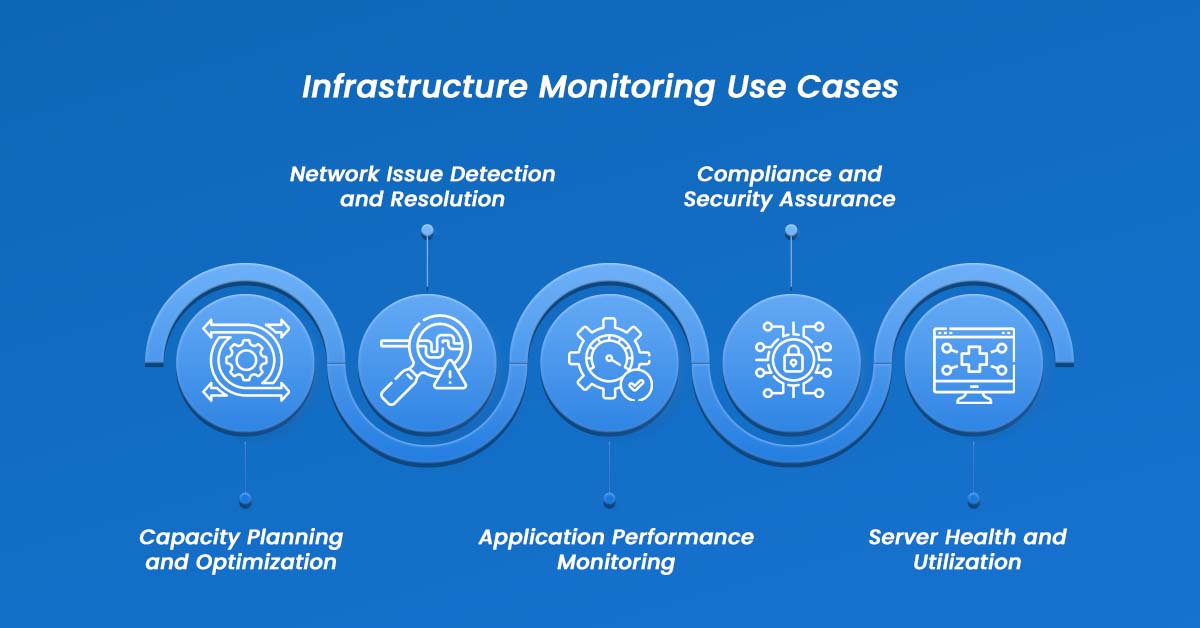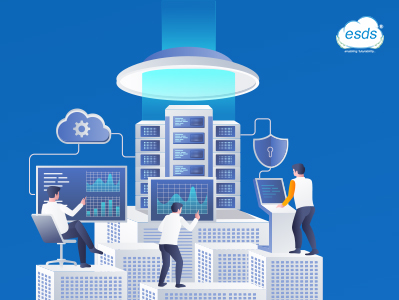What is Infrastructure Monitoring and Why Infrastructure Monitoring Tool is Important for Your Business?

Today organizations heavily rely on their IT infrastructure to drive business outcomes and deliver a seamless user experience. As technology evolves and becomes more distributed, it is crucial for businesses to prioritize infrastructure monitoring. This process involves collecting and analyzing data from IT infrastructure, systems, and processes to ensure availability, performance, and resource efficiency. By implementing infrastructure monitoring, organizations can proactively detect issues, optimize performance, and prevent costly downtime.
This blog post includes
- What is Infrastructure Monitoring?
- Challenges of Infrastructure Monitoring in Cloud Environments
- Benefits of Infrastructure Monitoring
- Infrastructure Monitoring Use Cases
- How to select an Infrastructure Monitoring Solution?
What is Infrastructure Monitoring?
Infrastructure monitoring is like oxygen for your IT infrastructure. It collects and analyzes data from various components such as cloud environments, operating systems, storage, servers, and virtualized systems to provide a complete picture of availability, performance, and resource efficiency. With infrastructure monitoring, businesses can optimize their requirements and user experience, handle traffic spikes, detect outages and performance degradations, and pinpoint root causes of issues.
As applications and services have become mission-critical for organizations, infrastructure monitoring plays a vital role in ensuring their availability and performance. In this hyperconnected world, where millions of people rely on digital properties for essential services like healthcare, finance, and shopping, infrastructure monitoring enables organizations to respond proactively to issues and prevent loss of time and money.
Challenges of Infrastructure Monitoring in Cloud Environments
Modern infrastructure monitoring faces unique challenges in cloud environments, especially in multicloud setups. Each cloud vendor provides native monitoring tools, making it difficult for organizations to gain a comprehensive view of their cloud infrastructure. Additionally, with the transition to cloud-native technologies and microservices-based architecture, organizations need to adopt best practices for managing their new cloud infrastructure.
Infrastructure monitoring helps overcome these challenges by providing critical intelligence to optimize the health and utilization of cloud-native environments. It ensures reliable performance, high-quality user experience, and better service delivery. By leveraging infrastructure monitoring, organizations can manage network issues, ensure compliance and security, track server health and utilization, plan and optimize capacity and monitor application performance.
Benefits of Infrastructure Monitoring

Organizations can’t afford to wait for alerts when a system or application component fails. They need to adopt a proactive approach to identify and resolve potential infrastructure issues before they impact the user experience. Infrastructure monitoring offers several benefits in achieving this goal:
1. Accelerated Root Cause Analysis: Infrastructure monitoring enables quick identification of issues and empowers cross-functional teams to collaborate effectively. By resolving problems before they escalate, organizations can avoid major disruptions.
2. Performance Trend Analysis: Continuous monitoring of performance trends helps organizations understand peak performance, optimize where necessary, and proactively address potential issues. It also aids in A/B testing experiments and validating deployments.
3. End-to-end Observability: Infrastructure monitoring provides the ability to achieve end-to-end observability across the entire infrastructure. It ensures consistent delivery of customer expectations and helps organizations achieve their goals while scaling for growth.
4. Better User Experience: Monitoring user experience metrics such as page load times and latency provides real-time insights into infrastructure performance. This allows organizations to make adjustments and optimize the user experience.
5. Compliance and Security: Infrastructure monitoring helps organizations detect potential security threats and ensures compliance with relevant regulations and standards.
Infrastructure Monitoring Use Cases

Infrastructure monitoring is critical for modern IT operations as it enables organizations to proactively identify and resolve potential issues. Some common use cases of infrastructure monitoring include:
- Network Issue Detection and Resolution: By monitoring network traffic and metrics, infrastructure monitoring tools can identify bottlenecks and help network teams address them before they affect end users.
- Compliance and Security Assurance: Infrastructure monitoring allows organizations to detect security threats and ensure their infrastructure complies with regulations and standards.
- Server Health and Utilization: Real-time insights into server health, CPU usage, memory utilization, and disk space help organizations identify potential issues and ensure optimal application performance.
- Capacity Planning and Optimization: Infrastructure monitoring helps organizations identify areas where additional resources are needed, enabling informed decisions for maximum efficiency in capacity planning and optimization.
- Application Performance Monitoring: By monitoring metrics like response time, transaction volume, and error rates, organizations can detect and resolve issues to ensure smooth application performance.
Selecting an Infrastructure Monitoring Solution
Choosing the right infrastructure monitoring solution is crucial for organizations looking to modernize their IT infrastructure. Here are key attributes to consider:
- All-in-One Platform: Look for a monitoring solution that provides end-to-end visibility across the entire IT stack, breaking down silos between applications and infrastructure teams.
- AI-Assistance: AI-driven anomaly detection and benchmarking capabilities help focus IT teams on proactive action, innovation, and business results.
- Contextual Information: Beyond metrics, logs, and traces, ensure the solution provides UX and topology data to understand interdependencies within your infrastructure.
- Root Cause Analysis: The solution should offer actionable answers to problems in real time, down to the code level.
- Automation for Dynamic Environments: Look for automation capabilities that encompass discovery, instrumentation, baselining, agent life-cycle management, and problem analysis in large-scale dynamic environments.
- End-to-End Coverage for Hybrid Cloud: Comprehensive support for multi-cloud, third-party integrations, and cloud-native architectures is essential to monitor and optimize performance across your entire infrastructure.
When selecting an infrastructure monitoring solution, organizations should also tap into the expertise of the vendor. They can provide guidance and insights based on their experience with infrastructure monitoring deployments across different organizations.
All-in-One Infrastructure Monitoring for Modern Cloud Environments
In today’s fast-paced digital world, organizations need their software and IT infrastructure to run flawlessly. Infrastructure monitoring plays a crucial role in ensuring a comprehensive view of performance and availability across the entire IT ecosystem. eNlight 3600 offers a single-interface platform that delivers all-in-one infrastructure monitoring and end-to-end observability for modern environments, including hybrid cloud and cloud-native architectures.
With eNlight 3600, organizations gain contextual insights, precise root-cause analysis, and automation capabilities at scale. On top of it eNlight 360° is triple patented auto-vertical scaling technology for CPU, RAM, Bandwidth, and more that eliminates the need for manual adjustments.
Infrastructure monitoring should be at the core of any organization’s IT strategy, as it empowers businesses to proactively manage their infrastructure, optimize performance, and deliver a seamless user experience.
- Top 5 Data Center Trends for 2024 - October 11, 2023
- Top 15 Cloud Computing Trends 2024 - October 4, 2023
- What is Infrastructure Monitoring and Why Infrastructure Monitoring Tool is Important for Your Business? - September 20, 2023
